Trigger Point Therapy for Myofascial Pain (19 page)
Read Trigger Point Therapy for Myofascial Pain Online
Authors: L.M.T. L.Ac. Donna Finando

Pain pattern:
Pain in the distal posterior deltoid, possibly into the posterolateral upper arm. Pain may be sharply localized and deep in nature, and it becomes more apparent when pain and restrictions in infraspinatus are reduced. There is usually little restriction of movement.
Causative or perpetuating factors:
Overload stresses when reaching backward and upward.
Satellite trigger points:
Infraspinatus.
Affected organ system:
Digestive system.
Associated zones, meridians, and points:
Dorsal zone; Hand Tai Yang Small Intestine meridian; SI 9.
Stretch exercises:
- Starting with the arm at 90 degrees horizontal abduction, extend the arm toward the back, internally rotating at the shoulder. At the limit of extension, bend the elbow and touch the inferior angle of the opposite scapula.
- Pull the affected arm across the chest, using the other arm placed proximal to the elbow to guide the action.
Strengthening exercise:
Lie supine with the arm close to the torso and the elbow flexed to 90 degrees. Without moving the elbow and arm away from the torso, rotate the forearm as if to place the back of the hand on the floor. Return to the starting position.
Repeat eight to ten times. Hand weights may be used as strength develops to increase the work effort placed on the muscle.
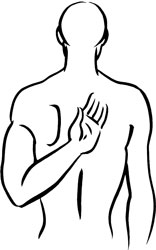
Stretch exercise 1:Teres minor
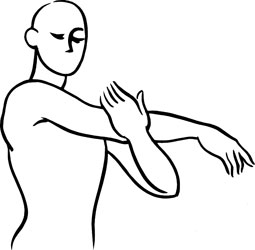
Stretch exercise 2:Teres minor
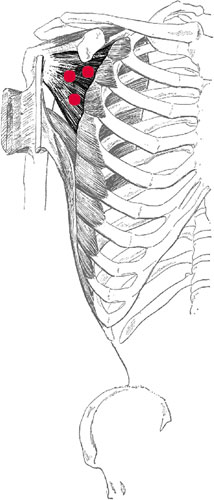
Subscapularis and trigger points
S
UBSCAPULARIS
Proximal attachment:
The subscapular fossa on the anterior (costal) surface of the scapula.
Distal attachment:
Lesser tubercle of the humerus on the anterior aspect of the humerus.
Action:
Internal rotation and adduction of the arm at the shoulder. Aids in stabilizing the head of the humerus in the glenoid fossa during movement of the arm.
Palpation:
Subscapularis is one of the four muscles that comprise the rotator cuff. The other muscles of the rotator cuff are supraspinatus, infraspinatus, and teres minor. This muscle may be quite difficult to palpate given its location on the anterior aspect of the scapula, adjacent to the thorax.
To locate subscapularis, identify the following structures:
- Lateral border of the scapula
- Posterior wall of the axilla, formed by latissimus dorsi
Palpation of subscapularis can be accomplished with the patient in either the supine or prone position. To palpate subscapularis, abduct the arm. Using flat palpation, reach under (anterior to) the posterior axillary fold, moving medial to both latissimus dorsi and teres major. Feel for the hard lateral border of the scapula with the pads of the fingers. Continue to reach medially, palpating subscapularis against the anterior aspect of the scapula along its lateral border. The extent to which the muscle can be palpated will depend on the degree of flexibility of the patient's scapula on the thorax.
Pain pattern:
Pain concentrates in the posterior deltoid area and may extend over the scapula and down the posterior aspect of the arm. It may skip the forearm to reappear as a band around the wrist. Symptoms are painful restriction of abduction and external rotation of the arm. Trigger points may contribute to a subluxation of the head of the humerus.
Causative or perpetuating factors:
Repetitive exertion requiring internal rotation, as in the swimmer's crawl; sudden shoulder trauma.
Satellite trigger points:
Pectoralis major, teres major, latissimus dorsi, long head of the triceps brachii, anterior deltoid, posterior deltoid.
Affected organ system:
Respiratory system.
Associated zones, meridians, and points:
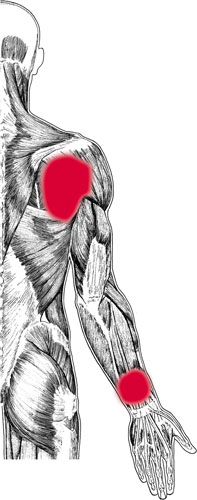
Subscapularis pain pattern
Dorsal zone; Hand Tai Yang Small Intestine meridian; SI 9 and 10.
Stretch exercises:
- Bend at the waist and rest one arm on a table, torso parallel to the floor. Allow the affected arm to hang straight down while holding a heavy weight. Move the weighted arm in small circles. This technique is also used to aid in the readjustment of the shoulder joint.
- With the forearms placed firmly on each side of a doorway, stretch the body through the outstretched arms, opening the chest and anterior shoulder region. First perform the exercise with the elbows level with the shoulders. Then extend the arms fully, placing the hands well above the head.
- With the elbow bent to 90 degrees, abduct the affected arm, raising the elbow to the shoulder level. Draw the forearm back behind the head. The stretch can be increased by applying a slight posterior pressure to the upper arm, just proximal to the elbow.
Strengthening exercise:
Lie supine with the arm close to the torso and the elbow flexed to 90 degrees. Without moving the elbow and arm away from the torso, rotate the forearm as if to place the back of the hand on the floor. Return to the starting position.
Repeat eight to ten times. Hand weights may be used as strength develops to increase the work effort placed on the muscle.
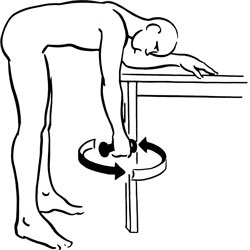
Stretch exercise 1: Subscapularis
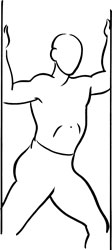
Stretch exercise 2: Subscapularis
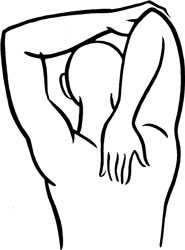
Stretch exercise 3: Subscapularis
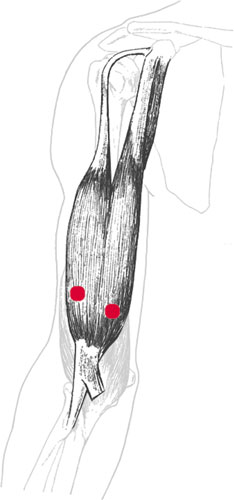
Biceps brachii and trigger points
B
ICEPS
B
RACHII
Proximal attachment:
Long head:
supraglenoid tubercle of the scapula.
Short head:
coracoid process of the scapula.
Distal attachment:
Tuberosity of the radius.
Action:
Flexion of the forearm at the elbow; assists in flexion of the arm at the shoulder. Aids in supination of the forearm against resistance when the elbow is flexed.
Palpation:
To locate biceps brachii, identify the following structures:
- Bicipital groove of the humerus (intertubercular groove)âIdentify the greater and lesser tuberosities of the humerus, just distal to the lateral aspect of the acromion. (These are best palpated with the arm externally rotated.) The bicipital groove lies medial to the greater tuberosity and lateral to the lesser tuberosity. Note that the tendon of the long head of the biceps brachii runs through the bicipital groove.
- Coracoid process of the scapulaâProjecting anteriorly from the superior border of the head of the scapula. Find the most concave aspect of the lateral clavicle; move your palpating hand distally approximately 1 inch into the deltopectoral triangle. Pressing posterolaterally, you will feel the bony prominence of the coracoid process. This area can be quite sensitive.